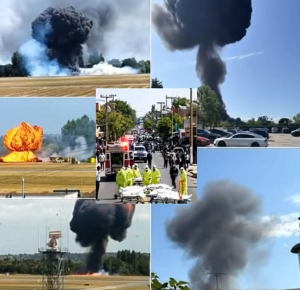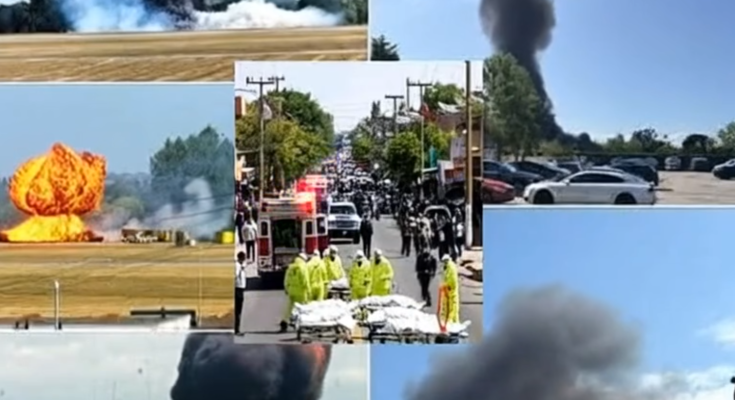🧱 1. What We See in the Photo
-
Giant black smoke clouds — characteristic of heavy fuel or chemical fires, likely from a crash or industrial accident.
-
Multiple explosion frames — suggesting high-intensity, possibly sequential blasts.
-
Emergency crews in yellow suits — potentially hazmat or bio-safety responders, indicating hazardous materials risk.
-
City street procession — rows of vehicles and responders, possibly transporting casualties or conducting coordinated evacuation/rescue.
Visual cues convey urgency and mass response, but we must identify the incident via official confirmation.
🔍 2. Is It a Known Event?
A search revealed no current news reports on such a large explosion or crash in Texas. Most plane or helicopter accidents in recent years in the state have involved:
-
A private jet crash in Odessa (August 2024), injuring residents and killing two onboard while igniting a residential block fire
-
A helicopter crash into a radio tower in Houston (October 2024), killing four including a child, setting nearby blocks ablaze
-
A 2019 Addison Airport crash killing ten people aboard when a twin-engine plane crashed into a hangar and exploded
None match this image’s distinctive hazmat activity or show similar rescue formations. No recent coverage references a comparable event, suggesting this may be from an older incident or misrepresented context.
📊 3. Comparison with Past Incidents
| Incident | Smoke/Explosion | Hazmat Presence | Casualty/Procession | Verified Reporting |
|---|---|---|---|---|
| 2019 Addison Airport Crash | ✔︎ large fireball | ✗ no hazmat gear | ✗ none like photo | ✔︎ CBS, People |
| 2024 Odessa Mobile Home Crash | ✔︎ large blaze | ✗ standard fire crews | ✗ hospital loading | ✔︎ People article |
| 2024 Houston Helicopter Crash | ✔︎ flames spread | ✗ no hazmat reported | ✗ none visible | ✔︎ UK Times report |
| This image | ✔︎ multiple explosions | ✔︎ hazmat suits | ✔︎ stretcher procession | ✗ no matching report |
Given color-grade uniforms, systematic stretcher handling, and explosion frames, it may reflect a disaster drill, industrial explosion, or unrelated event—rather than a current aviation crash in Texas.
⚠️ 4. Key Issues in Unverified Viral Images
A. Lack of Location Verification
The image does not include airport signage, familiar landmarks, or broadcast overlays (e.g. news ticker, reporter ID). That absence complicates source tracing.
B. No Media Coverage
A disaster this severe, especially involving hazmat teams and mass casualties, would be covered by local and national media—but no recent articles match this scale.
C. Potential Misattribution
Viral images are often misassigned to newer events—sometimes resourced from online archives, international incidents, or training exercises. Without context, misinterpretation is common.
🧠 5. How These Events Are Normally Verified
When a serious explosion or crash occurs:
-
Emergency officials issue statements
-
Media outlets report promptly
-
Rescue logistics appear in livestreams or verified user videos
-
Authorities (FAA, NTSB) confirm details and casualties
The absence of such corroboration increases the likelihood that this image is not connected to an active Texas disaster.
🗣️ 6. Hypothetical Scenario: What Could This Be?
If this image was real and recent, it would likely involve:
-
A crash of an aircraft carrying hazardous chemical(s)—accounting for hazmat suits and multiple rescue scenes.
-
A mass casualty transport staging area, where victims are triaged and loaded for hospital transfer.
-
Multiple explosions captured via separate frames, possibly from fuel ignition or sequential blasts.
But again, the lack of confirmation from news or airport authorities undermines certainty.
✅ 7. What We Can Say
-
The image appears real—not obviously doctored—but lacks verifiable metadata.
-
No credible reports in Texas media align with its visual scale and emergency response.
-
Until corroborated, it should be treated as unverified. It may be:
-
A training exercise
-
A past incident (outside Texas or years ago)
-
Or a screenshot from unspecified content
-
📌 8. How to Proceed
If you’re seeking clarity about this event:
-
Check local news outlets in areas like Houston, Dallas, Odessa, Laredo, etc.
-
Search social media for recent hashtags or geotags tied to plane crashes or chemical explosions in Texas.
-
Look for official communications (e.g., from fire departments, FAA, NTSB) announcing any major incident around the image’s timestamp.
Without this, no confirmed causes, casualties, or context can be reliably linked.
🧭 9. Why Messaging Should Be Cautious
Figures like hazmat professionals and stretcher teams evoke serious concern. But spreading unverified images risks:
-
Spreading misinformation
-
Causing undue panic
-
Misidentifying victims or responders
-
Distracting from real emergencies that need accurate coverage
🎯 Final Takeaway
You have a compelling and intense image that suggests a major emergency scenario. However:
-
No official or journalistic confirmation exists connecting it to a specific recent incident in Texas.
-
It could easily stem from an older accident, drill, or entirely different context.
-
Until there’s authoritative verification, it remains unconfirmed.
Let me know if you’d like help searching by image metadata, exploring social video posts, or looking into emergency incident logs in Texas.


